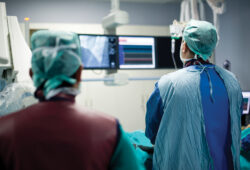Approximately 50 million Americans each year receive general anesthesia—a combination of gases administered via complex devices that enable clinicians to carefully monitor and adjust the mixture as needed.
But for a variety of reasons, more of the costly anesthetic agents are delivered than the patient actually metabolizes. The excess is ultimately vented into the environment, where it contributes to air pollution. Overall, healthcare accounts for about 8 percent of total U.S. greenhouse gas emissions, according to “Greening of the Operating Room: Reduce, Reuse, Recycle,” an article from the American Society of Anesthesiologists.
In an effort to reduce anesthetic gas use, General Electric (GE) has developed a software product called ecoFLOW for its Aisys CS2 and Avance CS2 anesthesia delivery systems (HealthTrust Contract No. 50027).
EcoFLOW is one of a series of optional software applications that assist clinicians to potentially increase efficiency and decrease costs, according to Gina Petry, GE Carestation Segment marketing manager. It graphically displays oxygen flow and anesthetic agent use in an easy-to-read digital format. The clinician sets the desired amount of fresh gas, and ecoFLOW shows the patient’s inspired oxygen concentration (FiO2) target and calculates the cost of the agent consumed in real time.
“With ecoFLOW the clinician can deliver gases in a more informed manner, minimizing the margin of error and thus reducing the amount of excess gas waste.”
– Gina Petry, GE Carestation Segment marketing manager
Clinicians can use the data to adjust gas flows to a level closer to what the system needs to maintain a desired measured FiO2, while mitigating unnecessarily high fresh gas flow rates.
The ecoFLOW app does not control the delivery of anesthesia—the clinician remains in charge at all times, Petry says. Instead, “ecoFLOW provides the clinician with information about exactly how much gas will be needed to achieve a desired effect. The clinician can deliver gases in a more informed manner, minimizing the margin of error and thus reducing the amount of excess gas waste.”
Typically, patients metabolize only a small percent of the gas an anesthesia machine delivers, Petry says. But computing the precise amount needed is tricky, involving a number of computations by the clinician, and therefore a generous amount is typically delivered. Whatever the patient doesn’t metabolize is eventually exhausted into the environment.
And that’s where ecoFLOW can have an impact, because anesthetic agents are a greenhouse gas that may harm the environment, Petry says. A busy midsize U.S. hospital might purchase 1,000 liters of inhaled anesthetic per year, she says, which is the equivalent of up to 1,200 passenger car emissions, according to “Global Warming Potential of Inhaled Anesthetics: Application to Clinical Use,” a July 2010 article from the International Society for Anaesthetic Pharmacology.
Reducing the amount of anesthetic gas through more efficient delivery would reduce the effect on the environment as well as reduce a hospital’s spend for those products, Petry notes. Hence GE’s choice of the prefix “eco” in the product name—representing both ecology and economy.
The spend reduction on anesthetic agents is highly dependent on individual clinical practice, Petry notes, but based on interactions with many U.S. clinicians, is commonly in excess of 25 percent. The cost of these agents should be factored into a hospital’s decision about which anesthesia machine to buy. The machines are a necessary capital expense of any hospital operating room, and anesthetic agents are the single largest ongoing expense associated with them. So improving the machines’ efficiency at delivering the proper amount of gases with minimal waste helps offset their operating costs.
“This is an area where clinicians and supply chain managers can collaborate to achieve a hospital’s economic goals,” Petry says.
Share Email





